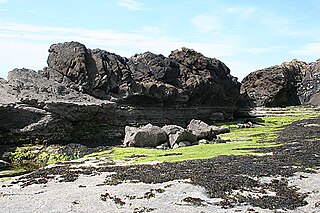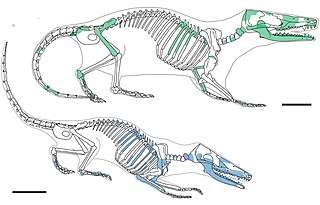
Multituberculata is an extinct order of rodent-like mammals with a fossil record spanning over 130 million years. They first appeared in the Middle Jurassic, and reached a peak diversity during the Late Cretaceous and Paleocene. They eventually declined from the mid-Paleocene onwards, disappearing from the known fossil record in the late Eocene. They are the most diverse order of Mesozoic mammals with more than 200 species known, ranging from mouse-sized to beaver-sized. These species occupied a diversity of ecological niches, ranging from burrow-dwelling to squirrel-like arborealism to jerboa-like hoppers. Multituberculates are usually placed as crown mammals outside either of the two main groups of living mammals—Theria, including placentals and marsupials, and Monotremata—but usually as closer to Theria than to monotremes. They are considered to be closely related to Euharamiyida and Gondwanatheria as part of Allotheria.

Megalosaurus is an extinct genus of large carnivorous theropod dinosaurs of the Middle Jurassic Epoch of southern England. Although fossils from other areas have been assigned to the genus, the only certain remains of Megalosaurus come from Oxfordshire and date to the late Middle Jurassic.

Echinodon is a genus of heterodontosaurid dinosaur that lived during the earliest Cretaceous of southern England and possibly western France in the Berriasian epoch. The first specimens were jaw bones named Echinodon becklesii by Sir Richard Owen in 1861, and since their original description only additional teeth have been discovered. The specific name honours collector Samuel Beckles who discovered the material of Echinodon and many other taxa from across England, while the genus name translates as "prickly tooth" in reference to the dental anatomy of the taxon.

Dolicorhamphus is an extinct genus of pterosaurs from the Middle Jurassic Taynton Limestone Formation and Fuller's Earth Formations of England. The genus contains two species, D. bucklandii and D. depressirostris.

Haramiyida is a possibly polyphyletic order of mammaliaform cynodonts or mammals of controversial taxonomic affinites. Their teeth, which are by far the most common remains, resemble those of the multituberculates. However, based on Haramiyavia, the jaw is less derived; and at the level of evolution of earlier basal mammals like Morganucodon and Kuehneotherium, with a groove for ear ossicles on the dentary. Some authors have placed them in a clade with Multituberculata dubbed Allotheria within Mammalia. Other studies have disputed this and suggested the Haramiyida were not crown mammals, but were part of an earlier offshoot of mammaliaformes instead. It is also disputed whether the Late Triassic species are closely related to the Jurassic and Cretaceous members belonging to Euharamiyida/Eleutherodontida, as some phylogenetic studies recover the two groups as unrelated, recovering the Triassic haramiyidians as non-mammalian cynodonts, while recovering the Euharamiyida as crown-group mammals closely related to multituberculates.

The evolution of mammalian auditory ossicles was an evolutionary process that resulted in the formation of the bones of the mammalian middle ear. These bones, or ossicles, are a defining characteristic of all mammals. The event is well-documented and important as a demonstration of transitional forms and exaptation, the re-purposing of existing structures during evolution.
Blapsium is an extinct genus of beetles from the Middle Jurassic of England. The only described species is B. egertoni, which is known from a single specimen found by the Earl of Enniskillen at the Taynton Limestone Formation, also known as the Stonesfield Slate. The specimen is deposited in the Natural History Museum, London. It is incompletely preserved, lacking a head, pronotum and legs. It has a broad, convex body. It has a very short metathorax, which may suggest that it was apterous.

Dryolestida is an extinct order of mammals, known from the Jurassic and Cretaceous. They are considered basal members of the clade Cladotheria, close to the ancestry of therian mammals. It is also believed that they developed a fully mammalian jaw and also had the three middle ear bones. Most members of the group, as with most Mesozoic mammals, are only known from fragmentary tooth and jaw remains.

Morganucodonta is an extinct order of basal Mammaliaformes, a group including crown-group mammals (Mammalia) and their close relatives. Their remains have been found in Southern Africa, Western Europe, North America, India and China. The morganucodontans were probably insectivorous and nocturnal, though like eutriconodonts some species attained large sizes and were carnivorous. Nocturnality is believed to have evolved in the earliest mammals in the Triassic as a specialisation that allowed them to exploit a safer, night-time niche, while most larger predators were likely to have been active during the day.

Amphitheriidae is a family of Mesozoic mammals restricted to the Middle Jurassic of Britain, with indeterminate members also possibly known from the equivalently aged Itat Formation in Siberia and the Anoual Formation of Morocco. They were members of Cladotheria, more derived than members of Dryolestida, and forming a close relationship with Peramuridae. Amphitheriidae is the only family of the order Amphitheriida.
Shuotherium is a fossil mammaliaform known from Middle-Late Jurassic of the Forest Marble Formation of England, and the Shaximiao Formation of Sichuan, China.
The Taynton Limestone is a geological formation in Oxfordshire in the United Kingdom. It dates to the Middle Jurassic, mid-Bathonian stage. It predominantly consists of ooidal grainstone. The term "Stonesfield Slate" refers to slaty limestone horizons within the formation that during the 18th and 19th centuries were extensively quarried for use in roof tiling within the vicinity of Stonesfield, Oxfordshire. Previously these were thought to belong to the Sharp's Hill Formation, but boreholes and shaft sections suggest that at least three horizons within the Taynton Limestone were quarried for the slate. These horizons are well known for producing a diverse set of fossils including those of plants, insects as well as vertebrates, including some of the earliest known mammals, pterosaurs as well as those of first dinosaur ever described, Megalosaurus.
Amphilestes is a genus of extinct eutriconodont mammal from the Middle Jurassic of the United Kingdom. It was one of the first Mesozoic mammals discovered and described.

The Kilmaluag Formation is a Middle Jurassic geologic formation in Scotland. It was formerly known as the Ostracod Limestone for preserving an abundance of fossil freshwater/low salinity ostracods. Gastropods, bivalves, trace fossil burrows, and vertebrate fossil remains have also been recorded from the formation. Vertebrate fossils include fish, crocodylomorphs, mammals, small reptiles, amphibians, theropod and sauropod dinosaurs and pterosaurs.

Phascolotherium is a genus of extinct eutriconodont mammal from the Middle Jurassic of the United Kingdom. Found in the Stonesfield Slate, it was one of the first Mesozoic mammals ever found and described, although like the other mammal jaws found at the same time, it was mistakenly thought at first to be a marsupial.

Borealestes is a genus of docodontan from the Middle Jurassic of Britain, first discovered on the Isle of Skye near the village of Elgol. It was the earliest mammaliaform from the Mesozoic found and named in Scotland. A second species and was later found in other Middle Jurassic sites in England, but is now shown to be a different genus. A new species, B. cuillinensis was named in 2021, also from Skye.
Wareolestes rex is a mammaliaform from the Middle Jurassic (Bathonian) rocks of England and Scotland. It was originally known from isolated teeth from England, before a more complete jaw with teeth was found in the Kilmaluag Formation of Skye, Scotland.

Palaeoxonodon is an extinct genus of cladotherian mammal from the Middle Jurassic of England and Scotland.
Vilevolodon is an extinct, monotypic genus of volant, arboreal euharamiyids from the Oxfordian age of the Late Jurassic of China. The type species is Vilevolodon diplomylos. The genus name Vilevolodon references its gliding capabilities, Vilevol, while don is a common suffix for mammalian taxon titles. The species name diplomylos refers to the dual mortar-and-pestle occlusion of upper and lower molars observed in the holotype; diplo, mylos.

Peramus is an extinct genus of cladotherian mammal. It lived in the Late Jurassic and Early Cretaceous of Europe and North Africa.




















